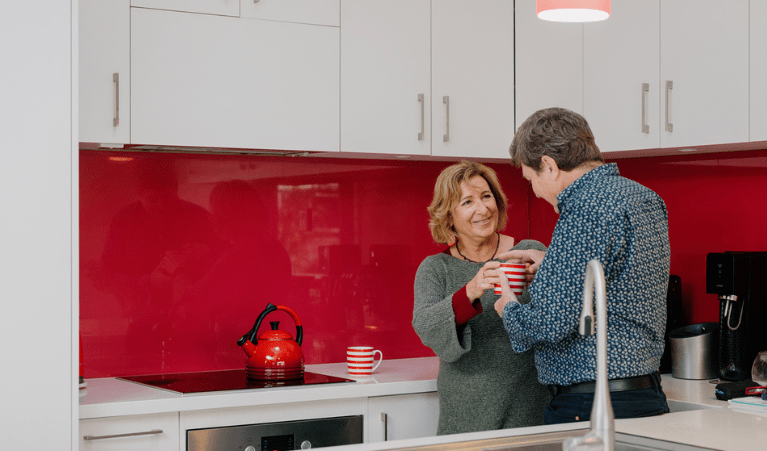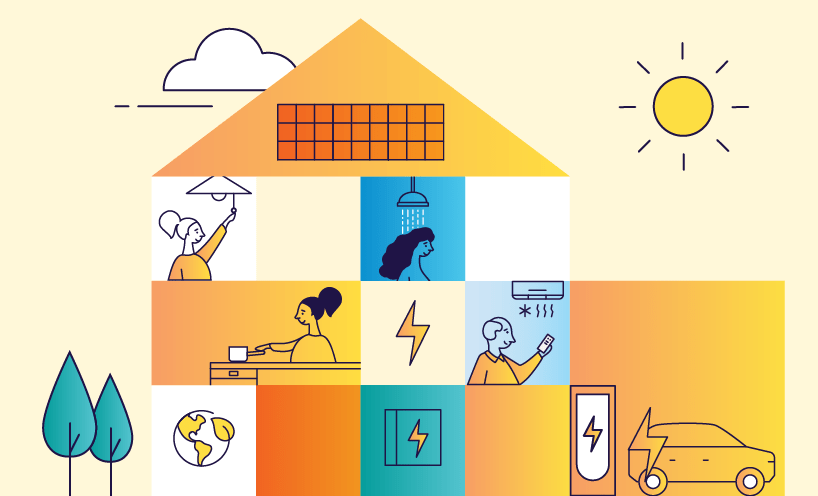With the arrival of her first grandchild, Deborah started thinking about what the future would look like for him, and became determined to do her bit to tackle climate change.
“We all know about 1.5° warming and the reality that we need to start looking at becoming as carbon neutral as we can. So we electrified the home. The bonus is we've saved a heap of money as well."
Deborah and Tim’s weatherboard house in Saint Kilda West was built around 1890. While features like high ceilings and wooden floors give it a heritage charm, they also made it costly to keep warm through Melbourne winters. Through thoughtful upgrades, they’ve achieved an energy-efficient, all-electric home that’s comfortable to live in and cheaper to run.
Despite her strong motivation to go all-electric, Deborah did have some hesitations. “I was concerned about the cost, and about what the appliances would be like. But we’ve worked out that we'll recoup all our money in about 10 years and the appliances have been an absolute breeze to use.”
Now, she’s full of advice and encouragement for others who are considering home electrification.
Heating, cooling and hot water
Deborah and Tim started out while they were renovating. The old stumps under their house needed replacing, and they took the opportunity to add underfloor insulation at the same time, knowing that heating was one of the biggest contributors to their high gas usage – and the associated high bills.
After double-glazing the windows as well, they could already see a change in their bills, which motivated them to keep going. They took more steps to draughtproof and insulate the house, reducing their reliance on heating and cooling. That included installing heavy-duty curtains, insulating the roof and walls, and preventing air escaping through gaps like ceiling vents, door frames, a skylight, and a fireplace.
“By keeping all the hot air inside in winter, and cool air in during summertime, we don’t have to heat or cool the house as much because it’s actually quite comfortable,” says Deborah.
Next, they replaced the gas heating system with energy-efficient electric heating. For the main living area, they chose a split system air conditioner, which can both heat and cool rapidly. And they installed electric radiators with thermostats throughout the house, which maintain warmth throughout winter.
They also replaced their hot water system, another big gas user. For this, they chose a heat pump system with tank storage.
“It’s fantastically efficient. We time it to heat the water during the day because we’ve got solar panels, which provide renewable energy.”
Induction cooking
The other gas appliance in the house was the cooktop, which they replaced with an induction stove. Switching to induction was an adjustment – but now Deborah raves about it.
“We do lots of cooking. We love entertaining,” says Deborah. “I was a little bit concerned because I was used to gas. But now I would never go back.”
She loves the fact that the induction cooktop is a breeze to clean with its flat glass surface, and the level of control it offers.
“I can put it on a really, really low simmer to do my caramelised onions, which take a long time at a low heat. But it's also really fast: if you put it on boost, you can get your hot water in the kettle much faster than an electric kettle, and it's much more efficient than that.”
It can also be set to turn off automatically, which is handy if something’s not quite finished cooking and she needs to rush out. And while (in their case) it did require replacing some pots and pans with compatible magnetic versions, Deborah saw this as a great excuse to get new cooking equipment.
Electric vehicle
As well as getting rid of gas in the house, Deborah and Tim have ditched petrol by getting an electric vehicle.
One of the benefits is much lower running costs. “Not only are we saving on petrol, but we save on servicing costs because an electric car doesn't need as much. There's no oil change, there's no moving bits that have to be changed, so that's a big saving over the course of a year.”
Because they don’t have off-street parking, they signed up to a trial with their local council to install a kerbside EV charger in front of their house. This means they can power the car with their own solar – for free.
Even at public chargers, fully charging the car’s battery (which gives them about 450 km of range) only costs around $25: much less than a tank of fuel.
“We go camping, we've travelled around Australia. It's fine; you just have to be a bit more planned with where your charging stations are.” And like most things these days, there’s an app for that.
To top it all off, “It's great fun to drive. It's really smooth and goes like a bomb if you want it to.”
Powered by solar
Deborah and Tim were early adopters of solar panels. Because technology has advanced so much since their first lot, they upgraded them as part of their all-electric renovation.
Their property has a heritage overlay, so they couldn’t have panels on the front of the house, which faces north (making it the ideal spot). Instead, they put panels on the other three sides to capture sun throughout the day as it moves across the sky.
Even though they now have more electric appliances in the house, they spend less than before on electricity thanks to their solar system.
“Having solar panels is excellent because I know that I'm actually not spending any money. I'm making the energy through the sun. So effectively it's free.”
Some small changes to their habits help them make the most of solar. “If I go out to work, I can just program the washing machine or the dishwasher to go off in the middle of the day when I know there's the most amount of sun happening.”
They also installed a solar battery to store energy that they make during the day but don't use. “So then in the evening we have our own little supply to run the heating and the cooking from. It makes it very efficient. I know I'm not making as much carbon dioxide and I'm not spending as much.”
They can also program the battery to fill up from the grid overnight at off-peak prices for them to use first thing in the morning.
Savings and other benefits
Going all-electric has made a huge difference to Deborah and Tim’s energy bills. They estimate that they’re saving about $3,000 each year thanks to powering everything with solar.
“Because we make so much solar energy over summer, we’re in credit with our electricity company for about nine months of the year. That credit covers us for a lot of wintertime bills. So our bills for electricity are minimal.”
“We don't have a gas bill anymore, which is great because gas is going up all the time. Our gas bills used to be about $1,200 a year and I know it's gone up since then.”
They spent around $30,000 upgrading their solar system and transitioning to all-electric, so they expect their investment to pay off in 10 years. After that, they can enjoy ongoing savings.
Plus, they’re already enjoying a more comfortable home, and the knowledge that they’ve done something to address climate change.
“Having an all-electric home that's powered by solar makes me feel really good,” says Deborah. “I feel good about the future, I feel good about my impact on the environment and I also feel like I've got a modern, clean house.”
Advice
The process of electrifying the whole house was daunting at first, but Deborah’s confidence grew as she took each step.
“We looked at Solar Victoria’s authorised retailers, chose one of those and spoke to them at length about what the options were. They were really responsive and answered all our questions. I felt empowered and we were supported every step of the way.”
Looking back, she has no regrets.
“The advice I'd have for anyone who's thinking about going all electric is that they just take it slowly. Get advice from the installer: they'll guide you through it. It's easy, and it's really worth it and I'm really happy I've done it.”
Updated




